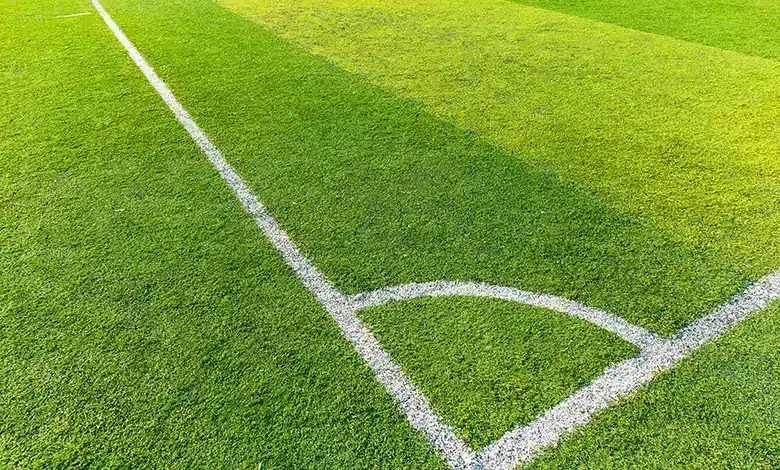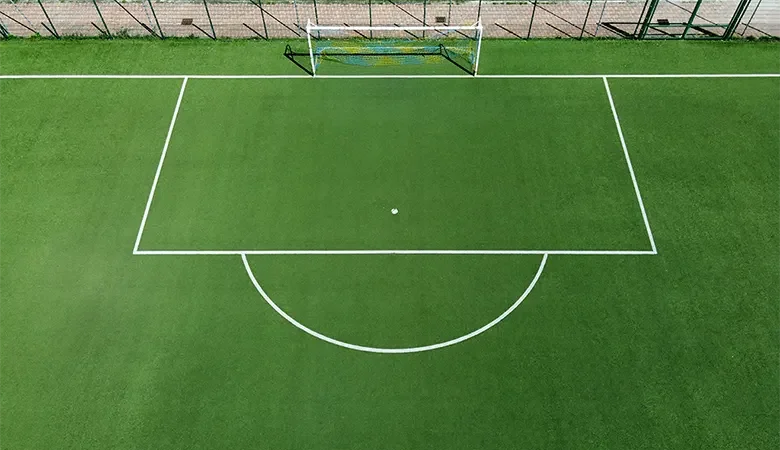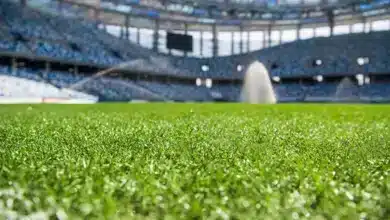
Soccer fields, (also known as a football pitch or football field) are the playing surface for soccer. The dimensions, measurements, and markings of the field of play are defined by Law 1 of the Laws of the Game. Understanding the specific requirements for a soccer field is crucial for ensuring optimal performance and safety during matches.
In this blogpost, we are going to share the dimensions, requirements and all the details of soccer fields.
Official FIFA Soccer Field Dimensions
Official FIFA soccer fields must be rectangular and marked with lines. They mark the boundaries of the area for the players. Touchlines mark the longer boundary lines, while goal lines mark the two shorter lines.
Two halves of the field are divided by a halfway line, which connects the halves. At the intersection of the halfway line is the center mark, around which a circle with a 9.15-meter (10-yard) radius is marked.
To ensure that defending players retreat when a corner kick is being taken, distance markings can be placed off the field of play at 9.15 meters (10 yards) from the corner arc and right angles to the soccer goal lines and touchlines.
The length of the soccer field touchline must be greater than the length of the goal line.
How Long is a Soccer Field?
It Depends.
The minimum length of the touchline is 90 meters (100 yards), and the maximum is 120 meters (130 yards).
The minimum width of the goal line is 45 meters (50 yards), and the maximum is 90 meters (100 yards).
For international matches,
The minimum length of the touchline is 100 meters (110 yards), and the maximum is 110 meters (120 yards).
Likewise, the minimum width of the goal line for international matches is 64 meters (70 yards), and the maximum is 75 meters (80 yards).
Recommended Soccer Field Sizes for Children and Youth
These FIFA official soccer field dimensions apply to men’s and women’s adult matches. For players 16 years or younger, the dimensions of the soccer pitch should be reduced in size. The recommended standard soccer field sizes for children and youth soccer are as follows:
U7/U8 – 40 x 30 yards (36.5 x 27.4 meters) – 5v5 recommended soccer field dimensions
U9/U10 – 60 x 40 yards (54.9 x 36.6 meters) – 7v7 recommended soccer field dimensions
U11/U12 – 80 x 50 yards (73.2 x 45.7 meters) – 9v9 recommended soccer field dimensions
U13/U14 – 90 x 55 yards (82.3 x 50.3 meters) – 11v11 recommended soccer field dimensions
U15/U16 – 100 x 60 yards (91.4 x 54.9 meters) – 11v11 recommended soccer field dimensions
Minimum Distance Between Soccer Fields
The distance between soccer fields should be a minimum of six yards (5.5 meters) when they are adjacent. There should be four additional yards for spectators.
At 5.50 meters (6 yards) from the inside of each goalpost, two lines are drawn at right angles to the goal line. A line parallel to the goal line connects these two lines, which extend into the field of play by 5.50 meters (6 yards). The goal area refers to the space between these two lines and the goal line. This is known as the 6-yard box in soccer.
The Goal Area and Penalty Area
At 16.5 meters (18 yards) from the inside of each goalpost, two lines are drawn at right angles to the goal line. A line drawn parallel to the goal line connects these lines, extending into the field of play for 16.5 meters (18 yards).
A penalty area is defined as the area between these lines and the goal line. Each penalty area is marked with a penalty mark 11 meters (12 yards) from the midpoint between the goalposts and equally spaced from them. An arc is drawn within the penalty area with a radius of 9.15 meters (10 yards) from the center of each penalty mark.

Corner Flags and Flagposts
Each soccer field corner must have a non-pointed top flagpost and a flag not less than 1.5 meters (5 ft) high. A flagpost may also be placed at each end of the halfway line, not less than 1 meter (1 yd) outside the touchline. A quarter-circle (1 yd radius) is drawn around each corner flagpost inside the field of play.
The Goal and Playing Surface Requirements
On each goal line, a goal must be positioned in the center. In addition, there are two upright posts equidistant from each corner flagpost and a horizontal crossbar across the top of the goal. Wood, metal, or another approved material must be used for the goalposts and crossbars. The soccer goal size is 7.32 meters (8 yards) wide and 2.44 meters (8 feet) high.
In addition to the dimensions and markings of the soccer field, the playing surface itself has specific requirements. Natural grass is the preferred playing surface for soccer, but artificial surfaces are also permitted as long as they meet certain FIFA standards. The artificial turf must be green and provide a consistent ball roll and bounce, similar to natural grass. The surface must also be non-abrasive, non-slippery, and shock-absorbent to prevent injuries.
Final Words
In summary, understanding the dimensions, markings, and requirements for a soccer field is essential for players, coaches, and officials involved in the game. From the size of the field to the dimensions of the goal box and penalty area, each aspect of the soccer field plays a crucial role in creating an optimal playing environment that promotes performance, fairness, and safety for all.




I understand that measurements can vary greatly. While the dimensions of soccer fields that can be used for professional competitions may be standardized, there are often varying measurements for fields used for special purposes or for amateur and educational purposes. For example, high school soccer fields or multi-purpose soccer fields may have different dimensions..
Yes sure Aliya.
It’s normal for measurements to vary depending on their intended use.
Even in multipurpose fields or high school soccer fields, the measurements can differ within themselves, as in the example you gave.
Thank you for your comment.
Keep following us.
Would be great to know more information about multipurpose soccer field include of high schools. Greetings..